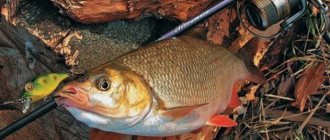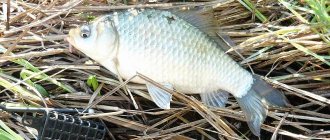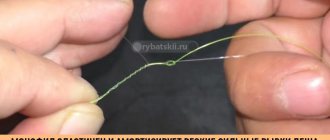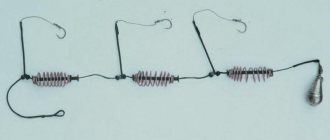By using a tackle with a shock-absorbing rubber band, the angler increases his chances of catching the desired prey. The soft but elastic material of the elastic band perfectly dampens the persistent jerks of the caught and resisting prey and thus forces it to give up, reducing to zero all its desire to free itself.
From this article you will learn all the details about this element of fishing equipment, what fishermen use it for, what properties and functions it has, you will learn about fastening methods and possibilities of use in various types of gear, and we will also tell you how to make a shock absorber with your own hands .
Content
- 1. What is a rubber shock absorber for fishing
- 2. Why do you need a rubber shock absorber in fishing rigs?
- 3. Where is a rubber shock absorber used?
- 3.1. Rubber shock absorber in feeder installations
- 3.1.1. Why is a shock absorber installed in feeder installations?
- 3.1.2. Alternative to feeder rubber
- 3.1.3. Features of installing a rubber shock absorber in a feeder installation
- 3.1.5. How to hook fish if a shock absorber is installed?
- 3.2. How to install a rubber shock absorber on a fly rod
- 3.3. Rubber shock absorber in plug
- 3.3.1. Material of rubber shock absorbers for plug
- 3.3.2. How to choose the right diameter for the rubber shock absorber in the plug
- 3.3.3. How to install a shock absorber on a plug
- 3.4.1. Making a rubber shock absorber for float fishing
How to tie a fishing line with an elastic band correctly?
The most important condition for quality tackle is good and strong knots. The shock absorber rubber bands are attached using very simple, but durable and strong units. One of the best tying techniques is the clinch. Taking into account the choice of technique for preparing loops for leashes, the method of their installation differs. A simple technique - “loop to loop” - involves creating loops on the main fishing line. On the opposite side of the leash, make a standard loop or figure eight.
You can improve the method by attaching a swivel clasp to the free edge. If the fishing rubber for the donkey breaks or the leash gets damaged, the fisherman will be able to replace the element of the tackle much faster. It will also speed up the disassembly process after fishing is completed.
Why do you need a rubber shock absorber in fishing rigs?
Rigs with a thin fishing thread are considered more catchy, but they have one significant drawback - they break easily, so anglers are faced with the choice of either durable equipment or a good bite. Installing rubber shock absorbers solves all the issues, as it allows the use of more delicate (thin) equipment and reduces the statistics of fishing line breaks.
Here you can find a selection of the best deals on fishing products we found on the aliexpress website. Thanks to this catalog, you can reduce the cost of installing gear by 2, and sometimes 5 or more times. You will find a detailed description of various products, their characteristics and justification for the benefits of purchasing them. And if you spend 10 minutes and learn how to use cashback, you can additionally save up to 15% on all purchases in a Chinese hypermarket.
The positive aspects of using shock absorbers in fishing also include:
- goes well in a duet with a braided cord, which has zero elongation;
- softens the jerk of the fish, which is performed with the aim of unhooking and prevents it from doing so;
- affects the flight range and accuracy of the bait falling to the intended point;
- when casting, it reduces the noise level of the equipment, and also allows the bait to enter the water space without noise.
Who doesn't know yet? You can return up to 15% of the price of your purchase on aliexpress. In addition to Aliexpress, the possibility of cashback (returning part of the money) also works for many other online stores. Here is a detailed description of this service and everything about how to work with it. It really works and helps you save a lot of money. The cashbacker website often runs promotions that allow you to buy goods at a discount of up to 90%.
Along with positive properties, the shock absorber also has disadvantages:
- it is installed for specific conditions and fishing location; changing it will take a lot of time to adapt it to other fishing conditions;
- rubber wears out quickly and requires constant monitoring of its appearance;
- at the moment the equipment breaks, the elastic band can cripple the fisherman due to its tensile properties.
Fishing technique
Fishing with a donk should not cause any particular difficulties. The fishing process itself differs little from ordinary donkey.
Despite the pre-selected shock absorber, when fishing you often have to adapt to real conditions
Fishing with a donk with a rubber shock absorber is carried out according to the following scheme:
- Installation of the buoy. You need to bring an improvised buoy to an area favored by fish: depressions, holes at the bottom, a quiet bay.
- Feeding the area. All bait is suitable, including soft bait or with a water-soluble coating.
- Throwing tackle. Beginner fishermen ask how to throw a rubber band at the bottom, but in reality there is nothing complicated, the tackle just looks oversized. The most difficult is the first cast, introducing the load. It is important to keep the line tension at the time of casting and remove objects that could interfere with the movement of the line so that the hooks do not get tangled.
- Waiting for a bite. Fishing with a rubber shock absorber comes down to waiting - when a fish bites the hook, the bite alarm will report this.
Where is a rubber shock absorber used?
3.1 Rubber shock absorber in feeder installations
The rubber shock absorber for the feeder is a piece of elastic designed for bottom equipment. When fishing with a feeder, shock-absorbing rubber bands are used, invented by the British “power gum” or “feeder gum”, which will be discussed in the following articles.
3.1.1 Why is a shock absorber installed in feeder installations?
Not missing a bite is one of the important points in feeder fishing, which is sometimes problematic, since feeder rigs use heavy feeders (rough equipment), which affects sensitivity. In order to catch the most delicate bite, you need to equip your fishing rod with sensitive equipment, which is achieved by installing a feeder elastic band.
2.1.3 Alternative to feeder rubber
Many anglers use plug rubber for their feeder rigs due to its elasticity and wide range of sizes.
If you don’t have such rubber bands in your arsenal, then you can use a multi-strand harness as a shock absorber, the main thing is to choose the right diameter.
But the feeder shock absorber from beaded elastic is made by fisherman A. Parovozov with his own hands
Rubber gloves can also be useful for making a shock absorber for a feeder, and see how to make one from this material on the “Wild Locksmith” channel
3.1.4 Features of installing a rubber shock absorber in a feeder installation
The diameter of the rubber shock absorber must correspond not only to the size of the fishing line, but also to the fishing conditions. For example, as the flow speed increases, the diameter of the shock absorber also increases.
How can you tell if the shock absorber section is selected correctly? In operation, that is (being at the bottom), your equipment should look as shown in this photo, that is, with a free distance of 2-3 cm between the tube and the cambric
To prevent the shock absorber from stretching in the feeder, it is fixed to the fishing line with a silicone stopper using a cambric.
How to check if the rubber band is working correctly? You need to conduct a test at the fishing site, read more about it here https://fishinginrus.ru/stati/rybalka-na-rusi/teoriya-i-praktika/680
One of the simple options for installing a feeder elastic from fisherman Sergei Markov, read here https://www.matchfishing.ru/fishing/articles/det1172811/
3.1.5 How to hook fish if a shock absorber is installed?
The hook must be smooth and sweeping, since the rubber shock absorber must first be stretched and then hook the prey.
3.2. How to install a rubber shock absorber on a fly rod
One of the methods of attaching an elastic band to the swing will be demonstrated by the Barnaul Fishing channel.
Equipping a fly rod is also possible in the following way:
- We shorten the stock (knee) of the fishing rod so that a hole opens through which the existing shock-absorbing elastic band can be pulled. If you feel sorry for a new rod, then in specialized stores you can buy a special whip and do everything on it.
- Attach a sleeve to the tip of the whip (can be secured with glue), along which the elastic band will slide.
- As a rule, the shock absorber is attached at the beginning of the 2nd or at the end of the 3rd warehouse of the fly rod using a collet plug or reel cone.
- The line is connected to the shock absorber through a connector. Moreover, the main thread should be half a meter shorter than the length of the tackle, this will help in managing the tackle.
For clarity of the mounting diagram, see the photo.
And here are the elements used:
- “A” - cone with reel;
- “B” - collet cone;
- “B” - Teflon bushing;
- "G" - connector.
Advice:
- use an elastic band with a diameter of 1 to 1.8 mm (the diameter directly depends on the size of the fish);
- the length of the elastic depends on where you started to attach it (2nd, 3rd leg of the fishing rod), but should not be less than 1.5 m;
- for fishing with this type of equipment, purchase a landing net with a long handle, since the shock absorber stretches strongly, which increases the distance to the fish;
- The elastic band tends to quickly become unusable, for this it needs to be inspected, especially in the area of \u200b\u200bthe connection with the connector.
Here, amateur fisherman Vladimir describes and schematically shows his invention (attachment of an elastic shock absorber), which he came up with in order to use a fly rod with an elastic band for fishing in wild, overgrown places. Also on the forum you will read the opinions of other reputable fishermen https://fishing-ua.com/threads/13151/
Alexander Stalyarov in his video will demonstrate how he uses a fly rod to catch carp on a rubber shock absorber
3.3 Rubber shock absorber in plug
A rubber shock absorber is an essential part of a plug fishing rod, located inside one, two or three upper knees of the fishing rod, that is, when a small piece of rubber is attached with one end to a stopper installed inside the knee, and the other to the connector (clasp). All accessories are attached to the connector.
3.3.1 Material of rubber shock absorbers for plug
The rubber used in the plug is made of latex or elastic. The latex shock absorber has a solid cross-section of 0.5 - 2.5 mm in diameter. This variety in the diameter of the elastic allows the fisherman to choose a shock absorber for specific fishing conditions.
Such shock absorber material as elastic is represented by a more limited number of diameters:
- 1;
- 1,6;
- 1,8;
- 2,1;
- 3 mm.
Elastic is inferior to latex; a diameter of 3.0 mm can be used for catching carp weighing no more than 3 kg. The advantage of elastic over latex is noticed in winter, since it does not freeze.
3.3.2 How to choose the right diameter for the rubber shock absorber in the plug
In order to make the right choice regarding a latex shock absorber, you should consider several rules:
- A shock absorber with a diameter of 0.7 mm is installed in two plug elbows. It has proven itself well in catching small fish (roach, bleak, gudgeon, dace) and in winter fishing. This diameter is perfect for catching fish up to 300 g. It goes well with fishing leashes of 0.06 or 0.07 mm, small fishing hooks. The disadvantage is that it wears out quickly; it is necessary to periodically bandage the connector, removing areas that have become unusable. In winter, the shock absorber in the plug shell freezes.
- A shock absorber with a diameter of 0.8 mm is considered universal and is installed in two or three elbows. Advantage - allows you to catch fish up to 1 kg, catches delicate bites, can be used many times, fits well with equipment up to 5 g, leashes with a diameter of 0.08 or 0.09 mm.
- A shock absorber with a diameter of 0.9 mm is installed on three elbows. It has proven itself well when catching small roach and large bream at different current speeds. Compatible with rigs from 8 to 10 g, 8 gram flat floats and leaders up to 0.12 mm. Disadvantage - you need to monitor the condition and bandage it during the fishing season.
- A shock absorber with a diameter of 1.0 mm is thick rubber, designed for catching fish from 300 g. Does not work well with thin equipment. For fishing with this diameter in strong currents, you can install a float weighing up to 12 g. The advantage is wear resistance, as a rule, it can withstand one fishing season.
- A shock absorber with a diameter of 1.2 to 1.6 mm is used for catching a specific trophy (large bream, perch, chub) in a high-speed current and is used with flat floats.
- A shock absorber with a diameter of 1.8 to 2.5 mm - this type of elastic is used in carp fishing, but it is advisable not to install a diameter exceeding 1.8 mm on a match plug rod.
In addition to the variety in diameter, the rubber shock absorber for the plug is distinguished by its elasticity, for example, the elastic band under No. 1 is thin and soft, but under No. 20 it is the most elastic. The thin shock absorber stretches strongly, which is noticeable even when catching small fish; for a beginner, the fishing process becomes difficult to control and difficult. The use of a large diameter negatively affects the sensitivity of the bite and causes the prey to disappear.
To help you make the right choice regarding the shock absorber you need, use this example table:
- No. 2 - for fish weighing from 50 to 100 g;
- No. 3-4 for fish weighing from 100 to 200 g;
- No. 5 for fish weighing up to 500 g;
- No. 6 for fish weighing up to 1.5 kg;
- No. 8 and 10 large, powerful, trophy fish.
In order for the rubber shock absorber to be effective, it is installed on certain knees of the tackle:
- No. 1 (0.5 mm) – 1 elbow;
- No. 2 (0.65 mm) - 1;
- No. 3 (0.75 mm) – 1 or 2;
- No. 4 (0.85 mm) – 2;
- No. 5 (0.95 mm) – 2;
- No. 6 (1.05 mm) – 2 or 3;
- No. 8 (1.25 mm) – 3;
- No. 10 (1.45 mm) – 3;
- No. 12 (1.60 mm) – 3;
- No. 14 (1.80 mm) – 3;
- No. 16 (2.0 mm) – 3 or 4.
An important element when installing the elastic is the bushing, which serves as protection (from contact with the sharp edges of the whip) and ensures free sliding. When choosing rubber, you need to take into account the diameter of this element. The rubber shock absorber should fit freely into its hole.
3.3.3 How to install the shock absorber on the plug
Andrey Kavchinsky will talk about this in detail in his video instructions.
3.4 Rubber shock absorber in float equipment
The use of a shock absorber in float gear, as well as in fishing with a plug, allows you to more effectively hook and fish out prey even when using the most delicate equipment.
The diameter of the rubber is selected according to the weight of the fish, see the table above.
3.4.1 Making a rubber shock absorber for float fishing
In his video, S. Maksimenko will tell you in detail how to make and secure a shock absorber for a float rod yourself
Selection of weights and leashes
During the manufacture of the leash, high-strength versions of thin fishing line (about 0.14–0.2 mm) are used. The length is set at your own discretion, but in standing water it is better to make it 10–20 cm, and in rivers with a current, the length of the leash is 30–40 cm. A hook is attached to the leash at one end, and a swivel is installed at the opposite end, on which a fastener is attached or knitted loop.
Thanks to the weight of the sinker, contact with the bottom of the reservoir is ensured. There are no restrictions on the shape, but many anglers prefer a flat weight, as it does not roll along the bottom in rivers with small currents. If the bottom is covered with a large layer of silt, it is better to use weights in the form of drops or balls. An alternative is to use a bag of stones, but this creates more noise.
Donks with elastic bands use relatively heavy weights
A separate piece of fishing line (about 30 cm) is made for the load, and a fastening loop with a shock absorber is mounted on the edge. The structure of the donkey with an elastic band may differ slightly, but it is impossible to attach the load to the main fishing line in all modifications.
The leader shock absorber will last longer with a lighter weight, so there is no need for too much lead. In any case, it is better to buy elastic for the donk with a reserve; if the tackle breaks during casting, it can be quickly restored.










